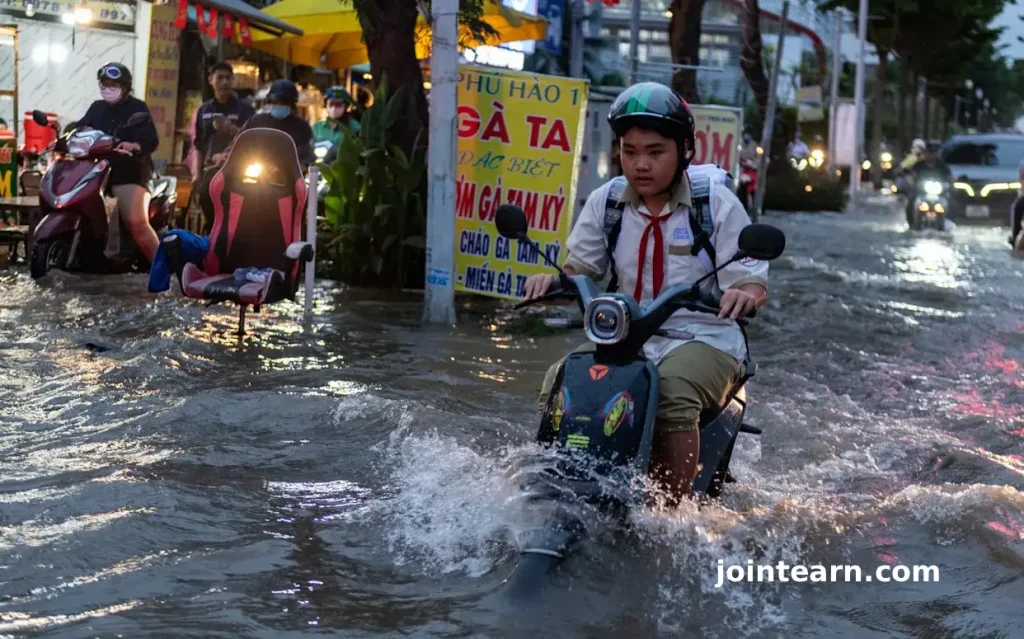
Typhoon Kalmaegi Leaves Devastation Across Vietnam
Typhoon Kalmaegi swept through central Vietnam on Friday, leaving at least five dead and causing widespread destruction following its deadly passage through the Philippines, where it claimed 188 lives. The storm brought record rainfall, severe flooding, and high winds, leaving thousands of homes damaged and critical infrastructure disrupted.
In Vietnam’s Gia Lai province, the typhoon made landfall with sustained winds of up to 92 mph. Nguyen Van Tam, a local fisherman, described the storm’s ferocity:
“The roof of my house was just blown away. We were all safe, but the typhoon was really terrible, so many trees fell.”
Widespread Damage in Central Vietnam
The Vietnamese Ministry of Environment reported significant destruction:
- 57 houses collapsed in Gia Lai and neighboring Dak Lak provinces.
- Nearly 3,000 homes suffered roof damage or complete destruction.
- 11 boats or ships sank along the central coast.
- 1.6 million electricity clients lost power, with one-third of services restored by Friday morning.
Roads were blocked by fallen trees and debris, leaving communities stranded and hampering rescue efforts. In Ho Chi Minh City, flooding disrupted daily life, inundating streets and restaurants, highlighting the typhoon’s reach far beyond the central coast.
Typhoon Kalmaegi: A Record-Breaking Storm
Vietnam is among the most cyclone-prone regions in the world, typically experiencing around 10 tropical storms annually. Kalmaegi, the 13th storm of 2025, has exceeded expectations in intensity and destruction. The storm moved northwest toward Laos and is forecast to reach Thailand, which issued warnings for heavy rainfall and flooding across the northeastern region.
Before hitting Vietnam, Kalmaegi devastated the Philippines, particularly Cebu and Negros islands, where floodwaters swept away vehicles, homes, and shipping containers. Rescue teams continue searching for 135 people still missing after the Philippine death toll reached 188.
Ongoing Flooding and Vulnerability in Vietnam
Vietnam was already struggling with severe flooding from heavy rains in late October, which claimed at least 47 lives and submerged UNESCO heritage sites, including the former imperial capital of Hue and the ancient town of Hoi An. The rainfall in some areas reached 1.7 meters (5ft 6in) within 24 hours, breaking national records and overwhelming drainage systems.
With nearly 2,000 miles of coastline and over 2,300 rivers, Vietnam is highly susceptible to tropical cyclones, and storms like Kalmaegi pose significant risks to life, property, and infrastructure.
Regional Impact and Preparedness
Kalmaegi’s path highlights the vulnerability of Southeast Asia to tropical cyclones. Governments in affected regions, including Vietnam, Laos, Thailand, and the Philippines, have mobilized emergency services and issued warnings to mitigate casualties and damage.
Authorities continue assessing the full extent of destruction, coordinating relief efforts, and restoring essential services such as electricity, water, and transport. Communities remain on high alert as the storm progresses northward, threatening additional flooding and landslides.
Conclusion
Typhoon Kalmaegi 2025 has emerged as one of the most devastating storms of the year, causing fatalities, widespread flooding, and massive property damage in both the Philippines and Vietnam. The storm underscores the urgent need for disaster preparedness, resilient infrastructure, and timely emergency response in tropical cyclone-prone regions of Southeast Asia.


Leave a Reply